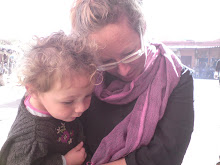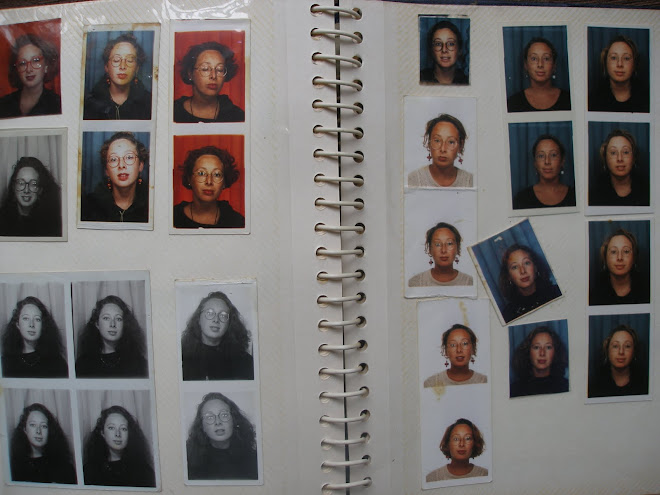A woman sits sideways on a sofa her left arm bent against the back with an open book in her hand. She is looking at the book which has a rusty red cover and is open about half way through. Her head is slightly tilted, her hair shines in the light that seems to come from above and a neat bun sits gently on her collar. In her lap leaning up against her bosom is a child. A little girl, who stares directly out from the painting and meets my gaze. The woman and the child are holding hands tenderly. The woman's hand is placed over the little girls so we cannot see either of her hands. I can feel the warmth of that little hand in mine. The girls right cheek is flattened against her mothers breast, she looks relaxed and comfortable – she owns the space beside this woman on the sofa. This is an intimate private moment between a mother and her daughter? Her cheeks are reddened perhaps she is hot or flushed. Maybe she is unwell and her mother is tending to her, reading a story to her and wishing her better. In the girls lap are some garden flowers, perhaps buttercups and daisies, yellow and white. Did the girl just pick them herself a little gift for her mother? A wisp of hair sits across her left brow before passing back behind her ear. She's not really smiling, her chin is ever so slightly raised and there is just a hint of of a frown which may indicate pain or illness. Is she gazing or dreaming; caught up in the pictures imagined from the story being read to her? She is lying out on the sofa both feet up, shoes with a blue flower touching the edge of the painting. The fabric on the sofa is blue and has a distinct pattern with flowers and lines. Simple but pretty. The girl also wears a blue dress with a white smock over the top, and a white lacy collar pops out of the dress at her neck buttoned under her chin.
My eye is rolling over the surface of the painting slowly taking in the whole picture one minute and then moving in closer searching for detail. I get up and move up closer to the painting, I look carefully at the texture of the paint and the colour. Lots of blue apart from the women's dress which is a strong solid mustard colour. Up close I now notice that a couple of the flowers one yellow and one white have escaped and are lying on the sofa behind the girl and another has dropped onto the woman's lap. This gives the picture a very domestic feel, a normal every day moment captured in time. Perhaps the woman has just picked the little girl up and in doing so she has dropped a couple of the flowers she was clutching in her hand. Is it nearly bed time?
Along the top of the sofa to the right of the painting is a doll – she is lying with her feet towards the girl and the girls lies the opposite way – they complement each other in the composition. They both have blue dresses. The doll has one little brown shoe missing and her left arm hangs limply down the sofa, face up with her hair tied back with a red ribbon. Where is the little shoe? Will it be found in the folds of the women's skirts or perhaps it has been missing for some time.
The mother and daughter for surely that is who they are, sit close together in the left half of the painting and the mother's head touches the top edge. It feels warm, intimate and real. The woman's green dress floats forward buttoned over her knees the bustle tucked neatly into the corner of the sofa. The paint is smooth, not thick, not thin. No real texture. Lightly applied. The girls dress might be silk but there isn't enough light suggested to see what the dress is made of.
This painting is by George Dunlop Leslie and it's entitled Alice in Wonderland. C. 1879 (that's seven years after Henry Hubbard died). Oil on canvas. How should I read this painting? How would the audiences at the time? Why did George paint it and who are the subjects in relation to him. Are they his wife and daughter perhaps. It is a tender and gentle image and I think these people are well loved by this painter. Idealised motherhood perhaps? And maybe not the most exciting or striking subject matter and certainly at other points in my life I would hardly have looked twice at it let alone spend 15 minutes alone with it – however, I have to confess I now find it reassuringly beautiful.
George Dunlop Leslie RA (2 July 1835 – 21 Feb 1931) was an English genre painter, author and illustrator. He often used children as subjects and his work was praised by John Ruskin for its portrayal of the "sweet quality of English girlhood". One of his pictures, "This is the Way we Wash our Clothes" was used as a poster in an advertising campaign for soap. Despite its apparently trivial subject matter, however, Leslie's work was highly regarded by critics of the time. Leslie was also an author and had several books published. "Our River" (1888), "Letters to Marco" (1893) and "Riverside letters" (1896) were all illustrated by him in black and white, and based on personal observations of life and nature in his local area. He also wrote a history of the early years of the Royal Academy - "The inner life of the Royal Academy". Leslie was married to Lydia. They had a daughter Alice (depicted in his painting "Alice in Wonderland").
























.jpg)









No comments:
Post a Comment